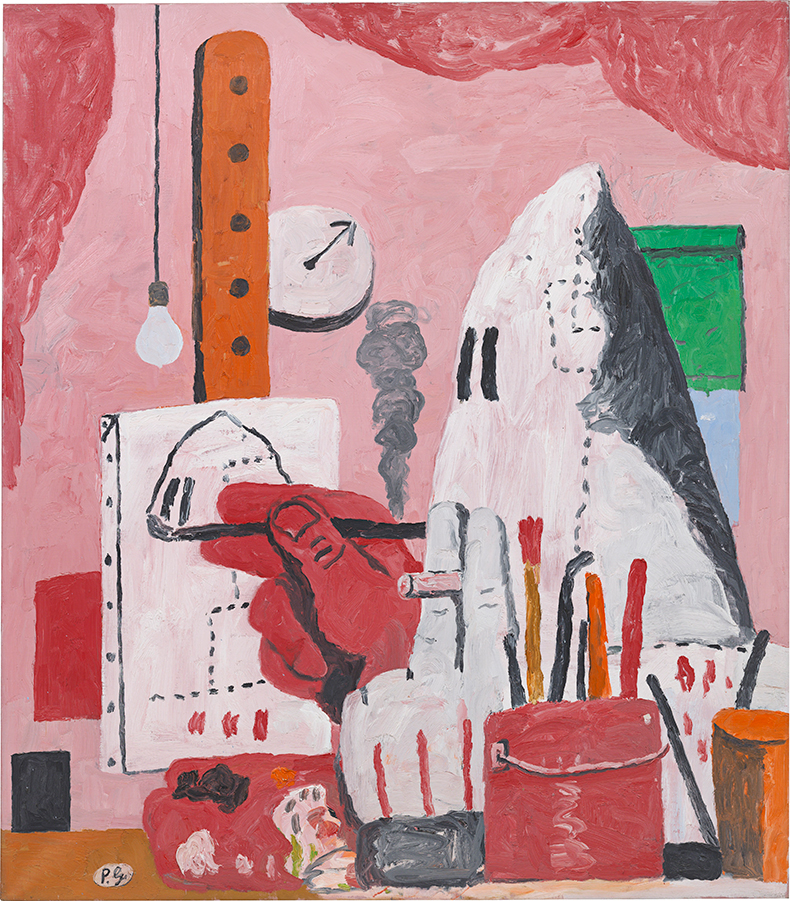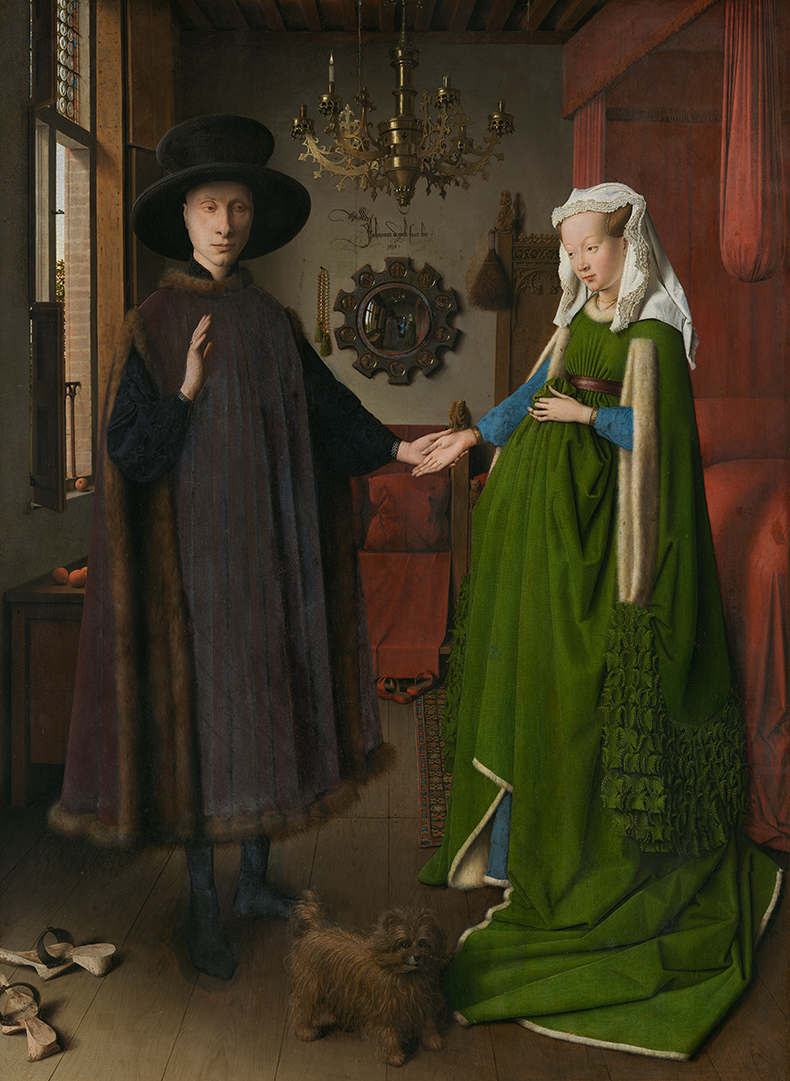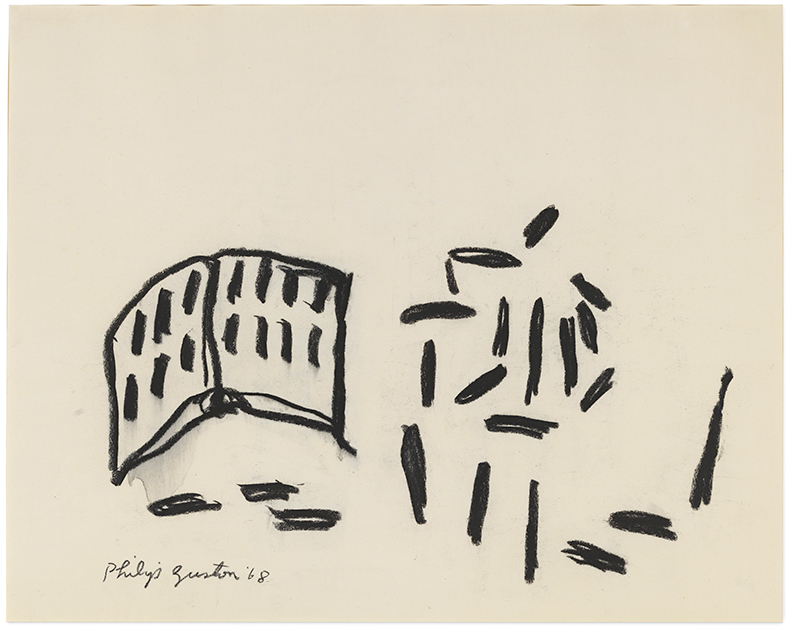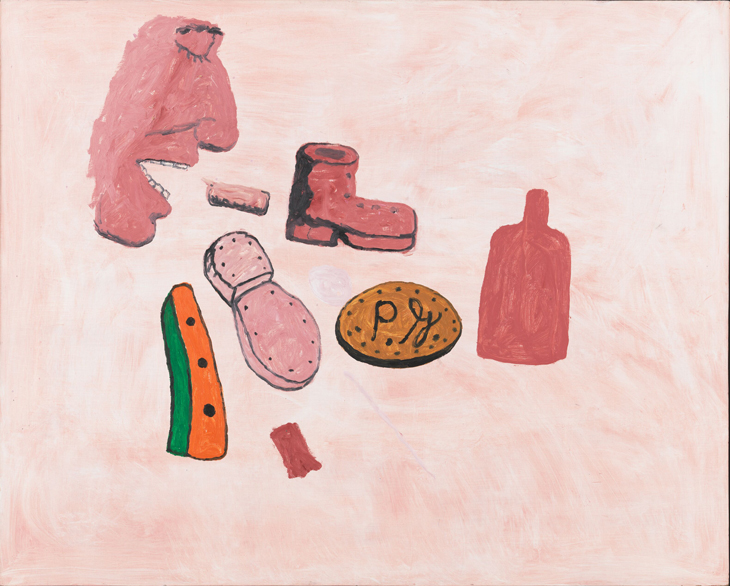Despite the drastic changes in his work, Philip Guston’s signature remained consistent. From about the mid 1940s onwards, that tidy cursive (always the full name, never abbreviated), remained in place, while beneath it slid a series of left turns: from crisp social realism into first ethereal, then gnarled abstractions, and finally into that last figurative decade that has become shorthand for his whole long and complex career – a route that is retraced in the major survey of his work that arrives at Tate Modern next month (5 October–25 February 2024), having already been presented at the MFA Boston, the MFA Houston and the National Gallery of Art, Washington, D.C. The exceptions prove the rule. When his initials appear on a painting (The Studio, 1969, and Painter’s Forms, 1972, are good examples), it’s Guston’s code for ‘not for sale’ – an endearing touch, given how few of Guston’s paintings were actually sold during his last decade. Yet as far out as some of those late paintings are, as wild and strange as they get, there it is, time and again: his full name, neat as a schoolboy’s.

The Studio (1969), Philip Guston. Courtesy Hauser & Wirth; © the Estate of Philip Guston
Guston’s signatures, like those of his Abstract Expressionist colleagues, vouchsafe the completion of works of art that might otherwise pass as unfinished. Joan Mitchell’s name on the canvas is not just a way of authenticating its authorship but also of assuring its viewer (or buyer) that yes, this one’s done. The long history of artists’ signatures is a kind of shadow history of art, in which the artist’s name and its place in the artwork undergoes shifts according to the cultural status of its author. Think here of Albrecht Dürer’s personal branding (‘AD’), the Duchess of Alba tracing Goya’s name on the sand, or, most famously of all, Van Eyck declaring himself not just the maker of the Arnolfini Portrait but a witness to the event it depicts (‘Van Eyck was here’), whatever that event might actually be.

The Arnolfini Portrait (1434), Jan van Eyck. National Gallery, London
In Guston’s time, signatures provoked a set of questions about the nature of authorship, from Robert Ryman’s use of his own name as a design element of his paintings, to the necessary elision of signature in the pared-down work of Joseph Albers or Donald Judd. By the 1960s, signing one’s name was an act that was, for many artists, so tainted by the art market that avoiding it became a full-time job. Bruce Conner’s refusal to toe the line so riled his dealer, Charles Alan, that he wrote him a stern letter, saying, ‘Oh Bruce, life would be so much simpler if you would grow up and sign your paintings.’ Another Bruce (Nauman) made perhaps the definitive work on the subject, a blue neon wall piece entitled My Name as Though it Were Written on the Surface of the Moon (1969), simply consisting of a single, cursive, ‘bbbbbbrrrrrruuuuuucccccceeeeee’.
In the light of these various assaults on the signature as token of an outdated model of artistic practice, Guston’s retention of the autographed canvas might seem out of step. And while there’s no doubt that his work was never really of its time, only finding its audience after Guston’s death in 1980, its concerns with the artist’s identity in the world were more current than was then recognised. ‘What kind of a man am I?’ asked Guston, famously decrying the abstractionist unable to assimilate the shocks of the world into his studio life. It’s a question that is not so much resolved as pushed centre stage in his later paintings. What kind of a man is that painting Klansman, that bedbound glutton, that bean-shaped chainsmoker? The late paintings deploy a language of abstract painting, seen in his late work’s unfailingly tender palette and squirming brushstroke, to probe at questions his abstraction never could. What kind of a man? This kind of a man. The signature is a sort of accusation.

Book and Charcoal Sticks (1968), Philip Guston. Courtesy Hauser & Wirth; © the Estate of Philip Guston
Anyone looking at a Guston from before 1935 is faced with a shock: a different name, Phillip (two L’s) Goldstein has signed the work. Guston changed his name in order, he later claimed, to please his non-Jewish prospective parents-in-law. It’s not hard, then, to see his lifelong fascination with masks and hoods, let alone erased or occluded surfaces, in the light of this suppressed childhood identity. Again and again in Guston’s work, bodies and objects are half sunk in water or crushed in piles. Rarely is something fully seen. Towards the end of his life, Guston voiced his regret at the decision to change his name. It’s a regret that is given voice, too, in the action of his paintings, right down to that neat and childlike signature at the bottom of each canvas. Yet as his friend, the composer Morton Feldman, pointed out, Phillip Goldstein was in fact there all the time: hidden in plain sight in the ‘P.G.’ with which he marked those paintings that, most tellingly of all, he refused to part with.

Painter’s Forms (1972), Philip Guston. Courtesy Hauser & Wirth; © the Estate of Philip Guston
‘Philip Guston’ is at Tate Modern, London, from 5 October–25 February 2024.
Ben Street is a writer, educator and art historian based in London.

The history of artists’ signatures is a secret history of art
Painter's Forms (detail; 1972), Philip Guston. Courtesy Hauser & Wirth; © the Estate of Philip Guston
Share
Despite the drastic changes in his work, Philip Guston’s signature remained consistent. From about the mid 1940s onwards, that tidy cursive (always the full name, never abbreviated), remained in place, while beneath it slid a series of left turns: from crisp social realism into first ethereal, then gnarled abstractions, and finally into that last figurative decade that has become shorthand for his whole long and complex career – a route that is retraced in the major survey of his work that arrives at Tate Modern next month (5 October–25 February 2024), having already been presented at the MFA Boston, the MFA Houston and the National Gallery of Art, Washington, D.C. The exceptions prove the rule. When his initials appear on a painting (The Studio, 1969, and Painter’s Forms, 1972, are good examples), it’s Guston’s code for ‘not for sale’ – an endearing touch, given how few of Guston’s paintings were actually sold during his last decade. Yet as far out as some of those late paintings are, as wild and strange as they get, there it is, time and again: his full name, neat as a schoolboy’s.
The Studio (1969), Philip Guston. Courtesy Hauser & Wirth; © the Estate of Philip Guston
Guston’s signatures, like those of his Abstract Expressionist colleagues, vouchsafe the completion of works of art that might otherwise pass as unfinished. Joan Mitchell’s name on the canvas is not just a way of authenticating its authorship but also of assuring its viewer (or buyer) that yes, this one’s done. The long history of artists’ signatures is a kind of shadow history of art, in which the artist’s name and its place in the artwork undergoes shifts according to the cultural status of its author. Think here of Albrecht Dürer’s personal branding (‘AD’), the Duchess of Alba tracing Goya’s name on the sand, or, most famously of all, Van Eyck declaring himself not just the maker of the Arnolfini Portrait but a witness to the event it depicts (‘Van Eyck was here’), whatever that event might actually be.
The Arnolfini Portrait (1434), Jan van Eyck. National Gallery, London
In Guston’s time, signatures provoked a set of questions about the nature of authorship, from Robert Ryman’s use of his own name as a design element of his paintings, to the necessary elision of signature in the pared-down work of Joseph Albers or Donald Judd. By the 1960s, signing one’s name was an act that was, for many artists, so tainted by the art market that avoiding it became a full-time job. Bruce Conner’s refusal to toe the line so riled his dealer, Charles Alan, that he wrote him a stern letter, saying, ‘Oh Bruce, life would be so much simpler if you would grow up and sign your paintings.’ Another Bruce (Nauman) made perhaps the definitive work on the subject, a blue neon wall piece entitled My Name as Though it Were Written on the Surface of the Moon (1969), simply consisting of a single, cursive, ‘bbbbbbrrrrrruuuuuucccccceeeeee’.
In the light of these various assaults on the signature as token of an outdated model of artistic practice, Guston’s retention of the autographed canvas might seem out of step. And while there’s no doubt that his work was never really of its time, only finding its audience after Guston’s death in 1980, its concerns with the artist’s identity in the world were more current than was then recognised. ‘What kind of a man am I?’ asked Guston, famously decrying the abstractionist unable to assimilate the shocks of the world into his studio life. It’s a question that is not so much resolved as pushed centre stage in his later paintings. What kind of a man is that painting Klansman, that bedbound glutton, that bean-shaped chainsmoker? The late paintings deploy a language of abstract painting, seen in his late work’s unfailingly tender palette and squirming brushstroke, to probe at questions his abstraction never could. What kind of a man? This kind of a man. The signature is a sort of accusation.
Book and Charcoal Sticks (1968), Philip Guston. Courtesy Hauser & Wirth; © the Estate of Philip Guston
Anyone looking at a Guston from before 1935 is faced with a shock: a different name, Phillip (two L’s) Goldstein has signed the work. Guston changed his name in order, he later claimed, to please his non-Jewish prospective parents-in-law. It’s not hard, then, to see his lifelong fascination with masks and hoods, let alone erased or occluded surfaces, in the light of this suppressed childhood identity. Again and again in Guston’s work, bodies and objects are half sunk in water or crushed in piles. Rarely is something fully seen. Towards the end of his life, Guston voiced his regret at the decision to change his name. It’s a regret that is given voice, too, in the action of his paintings, right down to that neat and childlike signature at the bottom of each canvas. Yet as his friend, the composer Morton Feldman, pointed out, Phillip Goldstein was in fact there all the time: hidden in plain sight in the ‘P.G.’ with which he marked those paintings that, most tellingly of all, he refused to part with.
Painter’s Forms (1972), Philip Guston. Courtesy Hauser & Wirth; © the Estate of Philip Guston
‘Philip Guston’ is at Tate Modern, London, from 5 October–25 February 2024.
Ben Street is a writer, educator and art historian based in London.
Unlimited access from just $16 every 3 months
Subscribe to get unlimited and exclusive access to the top art stories, interviews and exhibition reviews.
Share
Recommended for you
Mixed emotions – the uneasy art of Philip Guston
The artist’s motivations for painting hooded Ku Klux Klan figures were as complicated and unsettling as our reactions as viewers might be
The endless inventions of Bruce Nauman
Drawing, video, sculpture and performance – no medium is out of bounds for the titan of American art
Are Goya’s Black Paintings really the work of a madman?
A new biography of Goya puts paid to the romantic fiction that the Spanish master ended his days isolated and insane